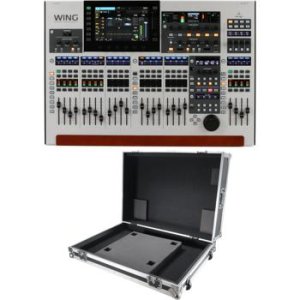Powerful. Expandable. Built Around You.
The Behringer WING is a 48-stereo-channel digital mixer that’s both ultra-powerful and incredibly easy to use. Benefit from first-class hands-on control, thanks to 24 smooth-feeling motorized 100mm faders, a capacitive touchscreen, adjustable display wheel, and touch-sensitive rotary controls. Capture sound with the utmost in quality, courtesy of eight MIDAS Pro mic preamps, while a bevy of digital I/O options provide near-limitless connectivity. Record up to 64 channels directly to dual-SD cards, use optional expansion cards to attain Dante support, or deploy the WING’s built-in 48-in/48-out USB audio interface to record straight to your DAW. Getting around the WING is a breeze, thanks to its intuitive Sources, which put the emphasis on your source audio rather than the nuts and bolts of your mix. Complete with 16 true-stereo processors with standard and classic modeled effects, the WING is a top-shelf digital console that will elevate your live sound capabilities.
Related Videos: WING 48-channel Digital Mixer
WING — made for the way you want to work
Digital mixers are insanely powerful; thus they can seem intimidating. That’s not the case with the WING. Despite its deep feature set, it’s a breeze to navigate. Its interface centers around a large capacitive touchscreen that’s augmented by touch-sensitive rotary controls. Best of all, its three fader sections and Custom Controls section can be tailored to your personal requirements. It doesn’t get much more intuitive than that! Whether you require a specific bus send fader next to the corresponding channel fader, or a meticulously configured custom channel that’s always at the ready, the WING is made for the way you want to work.
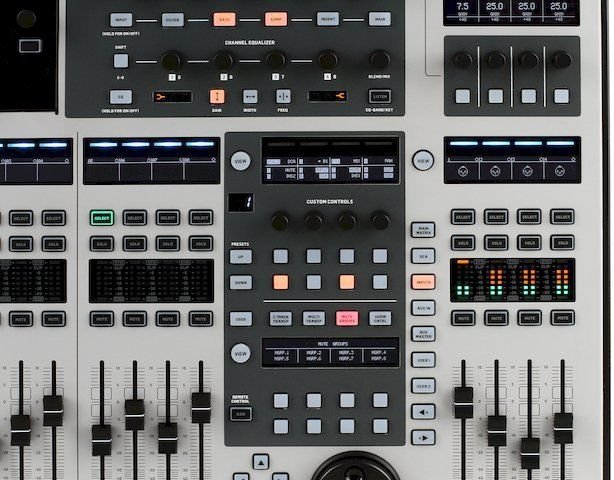
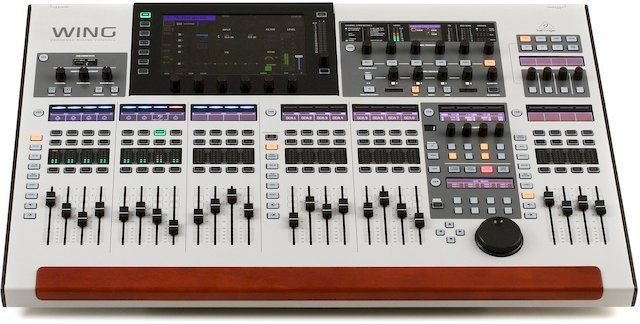
Sources make navigation simple
The WING is jam-packed with I/O — 374 inputs and outputs, to be exact. And if you include its internal signals, the WING includes 400 inputs and outputs. Faced with this much I/O, Behringer’s engineering team reimagined the flow of a traditional mixer, putting the emphasis on your source audio, using what Behringer calls — quite fittingly — Sources. In the WING, inputs are much more than historical inputs, because they contain metadata on what the Source is — tags, input icon, input color, gain, phantom power, and if the Source is mono, stereo, or mid-side. All of that information follows the Source to any channel. With one simple button, that information can be copied to the channel, and the tags, icon, color, and other metadata show up on the channel immediately. If you move a Source to another channel, the information goes with it, no need for old fashioned copying and pasting.
The implementation is carefully thought out, as well. Let’s face it, labeling and gain-staging 374 Sources can take some time. The workload can be easily split between two people as the WING is ready for dual operators. One person can be in charge of labeling the channels, including name, icon, color, tags, multiple mute groups, mono/stereo/mid-side configuration, and more. Using the 4-channel area of the WING as a separate work area, a second person can be in charge of gain-staging and determining phantom power for each source. To make things easier still, this can also be done from the WING Co-Pilot tablet app to label or set any of the parameters while patching from the stage. The beauty of this is whether you are looking at a channel, SD recorder, or any other output, you will always see and be able to refer to the Source.
Channels redefined
With so much focus on Sources, the WING has to go beyond the historical definition of what a channel is as well. With 374 Sources, a single 1-channel input seems a little underpowered. That’s why the WING has redefined what a single channel can do. Each of its 48 channels — 40 Inputs plus eight returns — can operate as mono, stereo, or mid-side. And when you assign a stereo Source to a channel, it automatically renders the channel in stereo. On top of that, each channel features an alternate (ALT) input that can be stereo as well, which makes toggling between two Sources a breeze.
The WING’s ALT inputs are a life saver. For example, say you have stereo tracks playing from a computer, but you also have a redundant hardware track player that’s synced to the computer. If the computer fails, the hardware tracks can take over with either a command or automatically. On a traditional console, that would take four channels. On the WING, it’s just one. Simply route the computer’s stereo Source to a single channel. Then specify the ALT input as the hardware player stereo signal. Other applications could be a redundant vocal mic. If the battery in a wireless transmitter unexpectedly goes out, the vocalist grabs a backup a microphone, and the signal immediately switches to the second mic. Again, this uses just one channel. Virtual sound checks have never been more straightforward. Just assign your 48 USB playback tracks or 64 XLive playback tracks to ALT inputs, hit play, and everything can automatically switch and be ready to go for your virtual soundcheck.ext
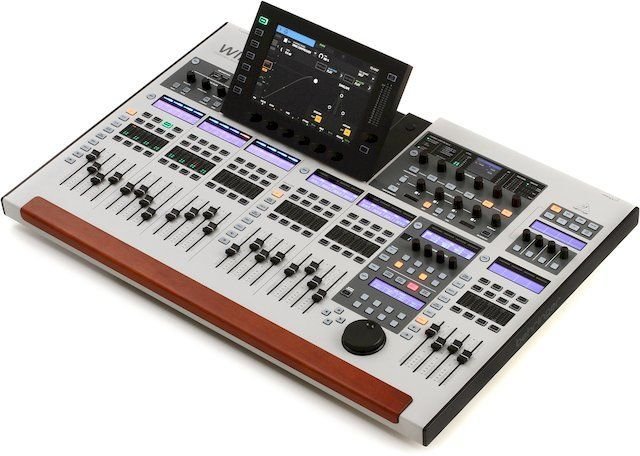
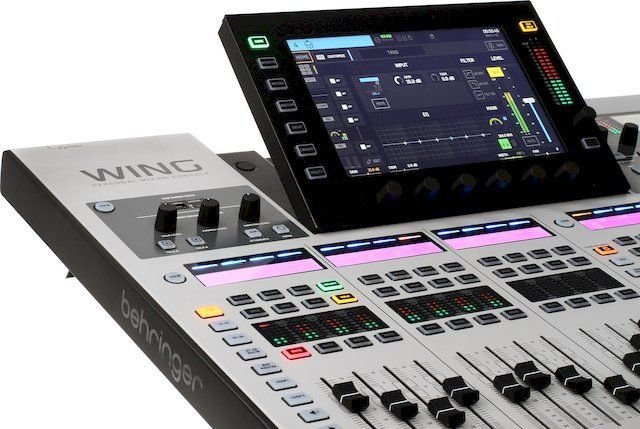
Mono or stereo? It’s all the same to the WING
All of the WING’s 48 input channels and 28 bus mixes can be used for mono, stereo, or mid-side sources — no channel linking required. And, as noted above, when you assign a stereo Source to a channel it automatically renders the channel in stereo. Best of all, there’s no need to reboot the console when you apply a mode change (the live sound engineers here at Sweetwater did back flips when they realized this). This means that you can make on-the-fly changes from mono to stereo and back again.
Innovative channel editing section for lightning-fast operation
Designed from the ground up for immediate channel status overview and flow of operation, the WING’s innovative channel editing section offers effortless operation. It’s tailor-made for multitasking, enabling you to work on the selected channel’s processing, even while the main display is being used for something else entirely. And the WING’s touch-sensitive rotary controls put the most relevant information right at your fingertips.
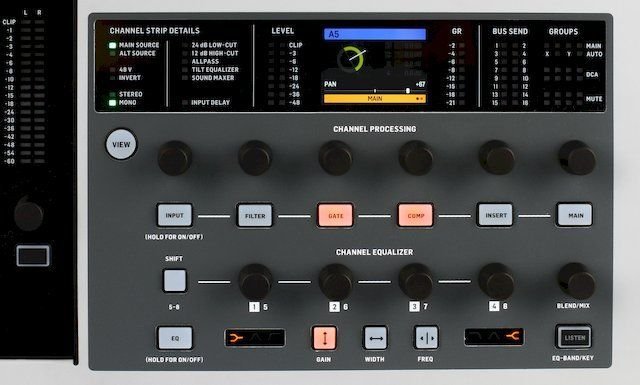
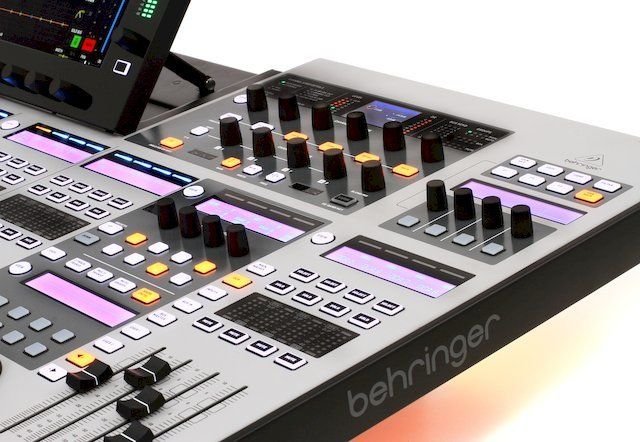
Benefit from first-class hands-on control
The Behringer WING supplies you with all the hands-on control you need. It all starts with 24 motorized 100mm faders. These ultra-smooth faders make this digital console an absolute joy to mix on. Its central section includes a bevy of user-assignable controls, including four touch-sensitive rotary encoders and 20 buttons with two LCD screens. Apply whatever functions you’d like to have within reach, and they’ll always be at your fingertips. Make fine adjustments of up to eight user parameters with the WING’s adjustable display wheel, or use it for DAW remote control via USB MIDI. The WING’s configuration also includes pre-defined functionality for USB and SD card recorder transport, show control, and mute groups.
Loaded with top-shelf processing
Putting a pro-quality sheen on your mixes is easy with the Behringer WING. A Standard FX rack with eight true-stereo processors supplies you with a useful array of modulation, EQ, and dynamics effects. Beyond that, you also get a second Premium FX rack with eight true-stereo processors with sought-after algorithms from TC Electronic’s M3000 multi-effects processor, as well as world-class effects from Lexicon, Quantec, and EMT. All 40 of the WING’s stereo input channels boast built-in EQ and dynamics, some of which are modeled after famous hardware from legendary manufacturers like Pultec, SSL, SPL, Neve, Focusrite, dbx, Universal Audio, Elysia, and Empirical Labs. Finally, this digital mixer’s four main, eight matrix, and 16 stereo aux buses all feature dual inserts, 8-band parametric EQs, a stereo imager, and full dynamics processing.
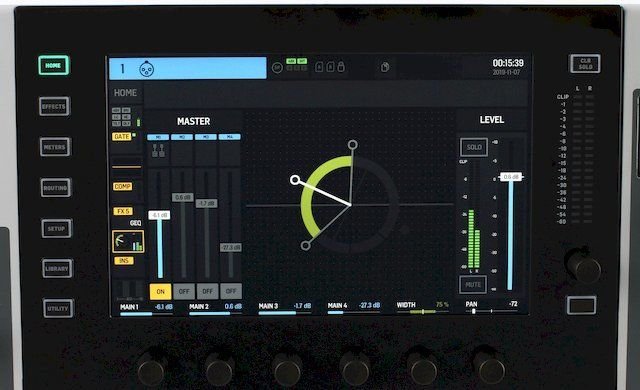
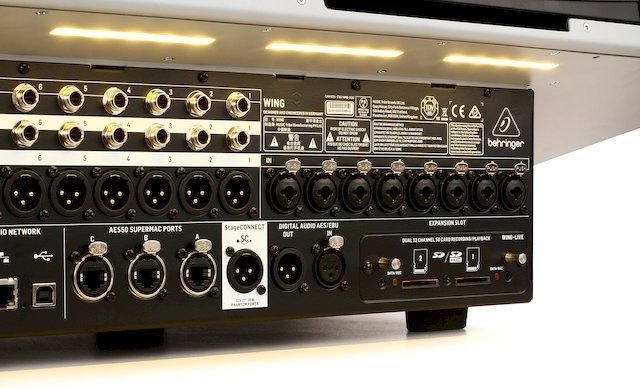
Packed with ample I/O and limitless expansion
The WING comes loaded with ample I/O and is highly expandable as well, granting you a tremendous level of flexibility. It all starts with 40 stereo input processing channels, as well as eight stereo aux channels. Output processing channels include 16 stereo aux buses, eight stereo matrixes, and four stereo mains. You’ll benefit from plug-and-play remote I/O connectivity for up to 144 input and output signals via three AES50 ports. The WING boasts AES/EBU stereo digital I/O, two headphone connectors, MIDI I/O, and four GPIO ports. It includes a WING-LIVE card, enabling up to 64 channels of 32-bit/48kHz audio to be captured directly to a pair of SD or SDHC cards. You can also install optional cards to attain Dante support. On top of that, the WING makes a great studio tool, thanks to its built-in 48-in/48-out USB audio interface, which includes DAW remote functionality that emulates HUI and Mackie Control.
Uncompromising design ensures top-shelf sound
When it comes to sound quality, the Behringer WING doesn’t compromise. 40-bit floating-point processing at 48kHz or 44.1kHz with 1ms round-trip latency yield the top-shelf sound you demand. Eight legendary MIDAS Pro mic preamps and eight MIDAS Pro XLR outputs ensure that you capture high-quality sound. Eight channels of line-level auxiliary I/O on balanced TRS connectors bring in signals from media players or computers with the utmost in fidelity. Need more? A built-in StageCONNECT interface adds 32 channels of low-latency I/O over a single XLR microphone cable. Using the WING’s three AES50 networks, you can connect to 144 Sources. What’s more, the AES50 networks are compatible with MIDAS M32 and Behringer X32 mixers. Simply join your current M32/X32 network, and you’re good to go. You can also add Dante for endless possibilities.
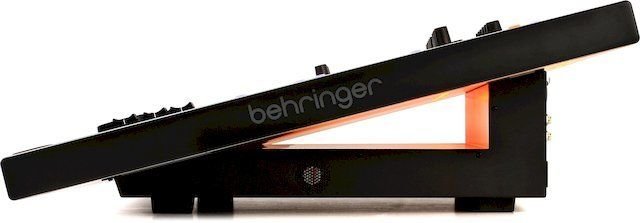
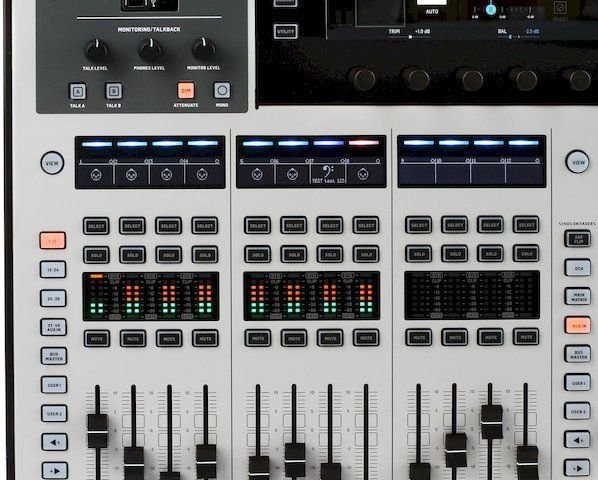
Fast, dependable automixing with Auto Pilot
When you need fast, dependable automixing, the WING’s Auto Pilot gives you exactly that, providing you with automixing with two groups of gain sharing on any 16 input channels. And we do mean fast — it automatically tracks which microphone is receiving the highest levels and instantly increases its channel gain, all while reducing the sum of gain for all other channels in the same group. And it sounds excellent — ambient noise remains low, while intelligibility and gain before feedback are increased. Auto Pilot is perfect for corporate events, panel discussions, house of worship, and broadcast applications with multiple speakers.
Behringer WING Digital Mixer Features:
- 48-stereo-channel digital mixer with 40 stereo input processing channels, as well as 8 stereo aux channels
- 28 stereo buses — 16 stereo aux buses, 8 stereo matrixes, and 4 stereo mains
- 24 smooth-feeling motorized 100mm faders in 3 separate, configurable sections
- 10.1” capacitive touchscreen, adjustable display wheel, and rotary controls provide touch-sensitive channel editing
- 8 MIDAS Pro mic preamps and MIDAS outputs ensure that you capture high-quality sound
- 3 AES50 ports provide plug-and-play remote I/O connectivity for up to 144 input and output signals
- AES50 networks are compatible with MIDAS M32 and Behringer X32 mixers
- 32-channel StageCONNECT interface for personal monitoring or analog I/O boxes
- Includes AES/EBU stereo digital I/O, 2 headphone connectors, MIDI I/O, and 4 GPIO ports
- Compatible with Behringer and MIDAS digital snakes, including the S16, S32, SD8, SD16, DL16, and DL32
- WING-LIVE card captures up to 64 channels of 32-bit/48kHz audio to a pair of SD or SDHC cards
- Optional expansion cards supply Dante support
- Built-in 48-in/48-out USB audio interface with HUI and Mackie Control DAW remote functionality
- Sources put the emphasis on your source audio rather than on your inputs and channels
- Apply names, icons, and colors to each Source for at-a-glance identification
- Each channel can be either mono, stereo, or mid-side — no channel linking required
- 16 true-stereo processors with effects from Pultec, SSL, SPL, Neve, Focusrite, dbx, Universal Audio, Elysia, and Empirical Labs
- Auto Pilot supplies fast and dependable automixing with 2 groups of gain sharing
- Dual solo/monitor buses per channel for monitoring over phones/IEM and/or floor wedges
- Support for binary and OSC communication for remote operation
- WING Co-Pilot tablet app enables you to label or set parameters while patching from the stage


